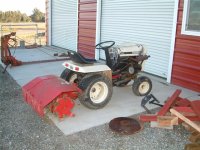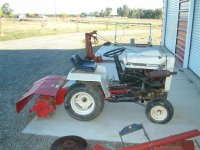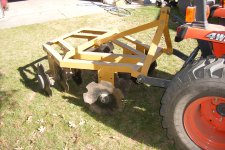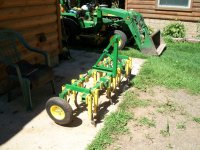That is probably too small of an area for a pull-type disk to be effective. But, I don't like 3-point disks for any use other than small areas (under 1/2 acre) in rocky soil, where road transport is an issue. Pull-disks (drag or lift-type) are considerably more fuel efficient than 3-points on larger areas. You can verify that by tractor dealer specs. and a little "real" usage. For example, my 28 hp, 2 wheel drive, tractor is rated for an 8 foot wide pull-type, or a 6-1/2 ft wide 3-point. Not only is less operation required each time out, due to the wider width (dealer verified), but the drag-disk also gets the job done in less passes (usage verified), further multiplying the fuel saving advantage. For your spot, I think a tiller is the way to go. I understand that tillers are not all that much more expensive than a 3-pt disk, and the tiller gets the job done in a single pass. I have around 40 years experience in this area, in which time I have used (6) different drag-style pull-disks, (1) hydraulic-lift pull-type, (2) 3-points, and (2) rototillers. Currently, all of my fields are 1-5 acres in size which is where the drag-style pull-disk really excels. Also, I never need to transport those disks over the road, which pretty much makes that a slam-dunk for me for that type of disk. The hydraulic-lift pull type is superior for larger fields, and the rototiller for smaller (if no rocks), especially if road transport is involved. For an area your size, fuel efficiency is not that big of deal, so I would probably go with a tiller unless I could find a good 3-point disk for 3/4 the cost or less. The good disk will also be considerably more reliable than the tiller, and have slightly lower maintenance cost.
One other thing to consider about disks, regardless of type is: I can think of no implement that benefits more from 4 wheel drive (except maybe a front loader). If you want to see that for yourself: work your disk , across a field, at a gps-verified ground speed, while the tractor is in 4 wheel drive. Note the engine rpms. Next, try maintaining that same speed with the tractor shifted into 2 wheel drive. To do that, you will need significantly more rpms. A higher engine rpm, at the same drawbar load, means proportionately higher fuel usage. Pushing that "dead" front axle thru the soft ground comes at a cost in fuel. With today's atmospheric fuel costs, that is why you wont see many real farmers pulling disks (or just about any other tillage tools) with 2 wheel drive tractors. I rarely ever even use my own disk behind my 2wd's these days for that reason. 4wd, coupled with about double the hp, allows me to pull that little 8-footer with the engine just above idle rpm, and quite fast if I want to.







